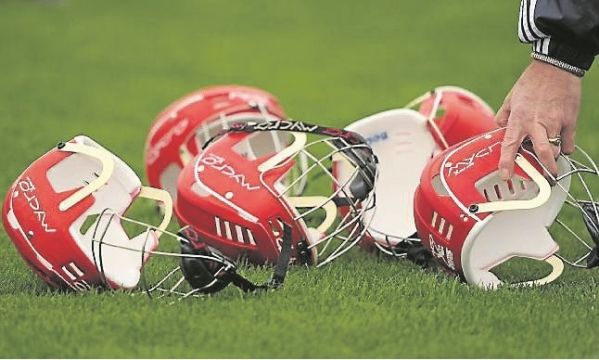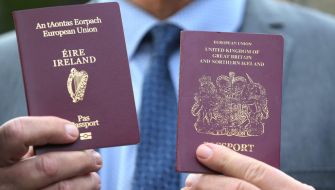Senior intercounty hurling and camogie players not wearing helmets meeting quality standards are at a higher risk of serious injury, a new study shows.
The GAA needs to have helmets inspected before games begin and that the Association needs to enforce the rules of players wearing this vital piece of protective gear that meets the IS355 standard, the Cork based authors recommend.
129 potential injuries were identified which resulted in the player not being involved in the game for at least five seconds in 56 hurling games, with 86 per cent of these involving non-standard helmets.
A worrying 5.5 per cent of injuries with non-standard helmets drew blood compared to zero per cent with standard. Non-standard helmets resulted in game stoppage that was 4.5 times longer.
This in turn leads to more serious injuries and longer stoppages in play along with leading to a significant financial cost to the GAA.
The study, A Video Analysis of Helmet Area Injuries and Helmet Type Worn in Hurling and Camogie Over 2 Seasons, in this month’s Irish Medical Journal also shows that seven potential injuries were identified in camogie with 43 per cent of these events involving players wearing non-standard helmets.
Injuries accounted for 51 per cent as a result of players not wearing head protection, 35 per cent when wearing helmets without face-guards and fiche per cent when helmets with full face-guards are worn.
Players sustaining a potential helmet area injury while wearing a non-standard helmet resulted in 4.5 times greater stoppage in game time.
There were 24 helmet area injuries, costing €18,710, in the hurling Insurance Benefit Fund.
In the report, 100 per cent of injuries were reported as players wearing standard helmets.
The results show players involved in potential injuries are more likely to be wearing non- standard helmets. This leads to more significant injuries and longer game stoppages.
GAA rules state that players must wear a standard helmet to make an insurance claim.
“€18,710 was paid for injuries to players wearing standard helmets in those two seasons, implying a significant burden to players wearing non-standard helmets, “ the study co-authors pointed out.
“Modifications are often made to helmets meaning that they no longer meet the IS 355 standard. Players have cited style, restricted view and comfort as being reasons to modify their helmets. Due to the fast, physical pace of the game, injuries to the helmet area range from soft tissue, boney, ocular, dental and concussion,” the authors warned.
Full match footage was reviewed for two seasons of hurling and camogie by the Cork University Hospital and the Irish College of General Practitioners authors. Potential injuries were defined as contact to the helmet area resulting in the player not resuming play within five seconds.
They analysed these events to assess if the player was wearing a helmet that met the IS355 standard. They also obtained the insurance claim data from the GAA to assess the financial cost of injuries to the helmet area.
The wearing of helmets became mandatory in hurling and camogie in 2010/2011. Prior to this, 51% of hurling injuries involved the area protected by the helmet. Since the introduction of mandatory helmet usage, injuries to the helmet area have fallen to 5%. Helmets worn are required to meet the National Standards Authority of Ireland, IS355 Standard.
In camogie, 43 per cent of the potential injuries identified were in players wearing non-standard helmets.
There also seemed to be a lower rate of potential injuries in the sport compared to hurling, 0.5 potential helmet area injuries per match versus 2.3 in hurling. It suggests that camogie players are more compliant with the wearing of standard helmets.
The co-authors recommend increased education of players, mentors and the wider playing community, in order to improve awareness of the need to wear these helmets. They also point out that players or teams should be “penalised” for non compliance.
“Consideration by the Associations to penalise players or teams with non-compliance of these safety rules of the association would likely improve compliance levels.” the authors highlighted.
“The GAA should enforce the wearing of standard helmets in order to reduce injuries, reduce the cost of injuries and reduce stoppages in play.”
They suggest that this could be integrated on a phased basis like the successful introduction of the helmet and face- guard from 2005 to 2010.
“We also advocate the re-introduction and enhancement of the GAA assistance fund to help purchase approved helmets. Finally, we recommend that the sale of helmets that do not meet the IS355 standard should be reported to consumer protection groups to safeguard the players, and parents, who may be subject to unsafe goods and misleading information.”
The study points out helmets can be bought from sports shops, online sales platforms and private mobile sales personnel to name a few, who sell the head gear which is not of the standard required or that were of the IS 355 standard and subsequently modified to suit their personal tastes.
The GAA previously had a grant in place in order to help teams and players purchase standard helmets. This was removed in 2020. The modification of helmets by players has been quoted to be done in order to improve visibility.
“When reading the IS355 specifications, it shows that the minimum field of vision while wearing the helmet, is similar to what the human eye can see while not wearing any headgear,” study co-authors warn.
“It is also worth noting that the wearing of non-standard helmets is against the rules of both games and may be offering a competitive advantage to players if they are not using the approved equipment.
At present, there is no assessment of players helmets prior to games to ensure that they meet the standard. This is currently done in Gaelic Football, another GAA sport, to ensure players are wearing gum-shields.
It is also done in sports such as Association Football to ensure players are wearing shin-guards and rugby to ensure players are wearing gum shields.
The study authors conclude that while it is “understandable that this could be a challenge to officials, we feel that it would be an important step to improve the safety of the sport.”
They believe their suggested measures will ensure the safety of hurling and camogie into the future.







